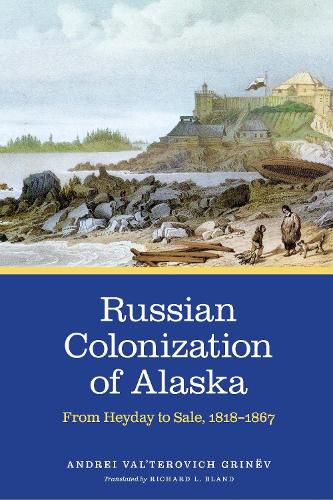Readings Newsletter
Become a Readings Member to make your shopping experience even easier.
Sign in or sign up for free!
You’re not far away from qualifying for FREE standard shipping within Australia
You’ve qualified for FREE standard shipping within Australia
The cart is loading…






In this third volume of Russian Colonization of Alaska, Andrei Val'terovich Grinev examines the final period in the history of Russian America, from naval officers’ coming to power in the colonies (1818) to the sale of Alaska to the United States (1867). During this time, in addition to the extraction of furs, other kinds of modern production continued to develop in Alaska, including shipbuilding, cutting and mining of timber and coal, and harvesting fish and ice for export. Grinev’s definitive volume explores how certain economic successes could not prevent the growth of crisis phenomena. Due to the low competitiveness of products and the distributive nature of the economy, the Russian colonial system could not compete with the dynamically developing Anglo-American capitalist colonization.
Russian Colonization of Alaska is the first comprehensive study to analyze the origin and evolution of Russian colonization based on research into political economy, history, and ethnography. Grinev’s study elaborates the social, political, spiritual, ideological, personal, and psychological aspects of Russian America, and accounts for the idiosyncrasies of the natural environment, competition from other North American empires, Alaska Natives, and individual colonial diplomats. The colonization of Alaska, rather than being simply a continuation of the colonization of Siberia by Russians, was instead part of overarching Russian and global history.
$9.00 standard shipping within Australia
FREE standard shipping within Australia for orders over $100.00
Express & International shipping calculated at checkout
In this third volume of Russian Colonization of Alaska, Andrei Val'terovich Grinev examines the final period in the history of Russian America, from naval officers’ coming to power in the colonies (1818) to the sale of Alaska to the United States (1867). During this time, in addition to the extraction of furs, other kinds of modern production continued to develop in Alaska, including shipbuilding, cutting and mining of timber and coal, and harvesting fish and ice for export. Grinev’s definitive volume explores how certain economic successes could not prevent the growth of crisis phenomena. Due to the low competitiveness of products and the distributive nature of the economy, the Russian colonial system could not compete with the dynamically developing Anglo-American capitalist colonization.
Russian Colonization of Alaska is the first comprehensive study to analyze the origin and evolution of Russian colonization based on research into political economy, history, and ethnography. Grinev’s study elaborates the social, political, spiritual, ideological, personal, and psychological aspects of Russian America, and accounts for the idiosyncrasies of the natural environment, competition from other North American empires, Alaska Natives, and individual colonial diplomats. The colonization of Alaska, rather than being simply a continuation of the colonization of Siberia by Russians, was instead part of overarching Russian and global history.